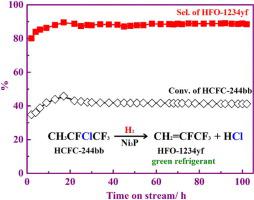Journal of Catalysis ( IF 6.5 ) Pub Date : 2020-08-28 , DOI: 10.1016/j.jcat.2020.08.022 Song Tian , Wei Mao , Pengfei Sun , Jingshuang Dang , Ling Zhou , Jian Lu , Erhard Kemnitz

|
Herein, we report a hydrogen-assisted selective dehydrochlorination of 1,1,1,2-tetrafluoro-2-chloropropane (HCFC-244bb) to 2,3,3,3-tetrafluoropropene (HFO-1234yf) over nickel phosphides (Ni2P, Ni12P5 and Ni3P) catalysts. The Ni3P catalyst exhibited higher activity and HFO-1234yf selectivity than Ni12P5 and Ni2P catalysts. An induction period over Ni3P was observed during the initial 15 h under reaction conditions of 300 °C and H2/HCFC-244bb of 1.5, then a steady HCFC-244bb conversion ~ 42% and HFO-1234yf selectivity ~ 88% was obtained within the rest of 105 h. The catalysts were characterized by in situ temperature-programmed desorption analysis, X-ray photoelectron spectroscopy (XPS) and transmission electron microscope (TEM). The in situ H2-TPD results reveal that Ni3P was capable of forming larger amount of active hydrogen species than the other nickel phosphides, but by comparing the desorption temperature the reactivity of active hydrogen species on Ni3P was weaker than those formed on Ni12P5 and Ni2P, leading to higher activity and HFO-1234yf selectivity of Ni3P. The theoretical calculations also find that the adsorption energy of H2 over Ni3P is lower than those over Ni12P5 and Ni2P. XPS and TEM-mapping show that a surface chlorination occurred on Ni3P during the initial stage of reaction, resulting in an increase of surface acidity. Thus, the enhanced catalytic efficiency of Ni3P during the induction period can be attributed to a synergism between the metal sites and the in situ formed weak acid sites, further promoting the C-Cl bond scission by active H species and inhibiting the deep-hydrogenation.
中文翻译:

通过磷化镍上1,1,1,2-四氟-2-氯丙烷的氢辅助选择性脱氯化氢突破性合成2,3,3,3-四氟丙烯
本文中,我们报告了在磷化镍(Ni 2上)上将1,1,1,2-四氟-2-氯丙烷(HCFC-244bb)进行氢辅助选择性脱氯化氢成2,3,3,3-四氟丙烯(HFO-1234yf)P,Ni 12 P 5和Ni 3 P)催化剂。Ni 3 P催化剂比Ni 12 P 5和Ni 2 P催化剂具有更高的活性和HFO-1234yf选择性。在300°C和H 2的反应条件下的最初15小时内,观察到Ni 3 P的诱导期。/ HCFC-244bb为1.5,则在剩下的105小时内获得了稳定的HCFC-244bb转化率〜42%和HFO-1234yf选择性〜88%。通过原位程序升温脱附分析,X射线光电子能谱(XPS)和透射电子显微镜(TEM)对催化剂进行了表征。原位H 2 -TPD结果表明,Ni 3 P能够形成比其他磷化镍更大数量的活性氢,但是通过比较解吸温度,活性氢在Ni 3 P上的反应性要弱于所形成的活性氢。在Ni 12 P 5和Ni 2 P上存在,从而提高了Ni 3的活性和HFO-1234yf选择性理论计算还发现,Ni 2 P上的H 2吸附能比Ni 12 P 5和Ni 2 P上的低。XPS和TEM映射表明,在初始阶段Ni 3 P上发生了表面氯化。反应阶段,导致表面酸度增加。因此,诱导期Ni 3 P催化效率的提高可归因于金属位点与原位形成的弱酸位点之间的协同作用,进一步促进了活性H物种对C-Cl键的断裂,并抑制了深氢键的形成。氢化。











































 京公网安备 11010802027423号
京公网安备 11010802027423号